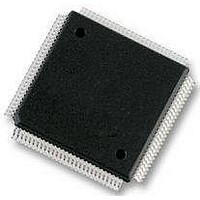MC9S12E128CPV Freescale Semiconductor, MC9S12E128CPV Datasheet - Page 314

MC9S12E128CPV
Manufacturer Part Number
MC9S12E128CPV
Description
Microcontrollers (MCU) 16 Bit 16MHz
Manufacturer
Freescale Semiconductor
Datasheet
1.MC9S12E128CPV.pdf
(606 pages)
Specifications of MC9S12E128CPV
Data Bus Width
16 bit
Program Memory Type
Flash
Program Memory Size
128 KB
Data Ram Size
8 KB
Interface Type
SCI, SPI
Maximum Clock Frequency
25 MHz
Number Of Programmable I/os
92
Number Of Timers
16 bit
Operating Supply Voltage
3.135 V to 5.5 V
Maximum Operating Temperature
+ 85 C
Mounting Style
SMD/SMT
Package / Case
LQFP-112
Minimum Operating Temperature
- 40 C
On-chip Adc
10 bit
On-chip Dac
8 bit, 2 Channel
Lead Free Status / Rohs Status
No RoHS Version Available
Available stocks
Company
Part Number
Manufacturer
Quantity
Price
Company:
Part Number:
MC9S12E128CPVE
Manufacturer:
Freescale Semiconductor
Quantity:
10 000
- Current page: 314 of 606
- Download datasheet (4Mb)
Chapter 10 Inter-Integrated Circuit (IICV2)
10.4.1.2
The first byte of data transfer immediately after the START signal is the slave address transmitted by the
master. This is a seven-bit calling address followed by a R/W bit. The R/W bit tells the slave the desired
direction of data transfer.
Only the slave with a calling address that matches the one transmitted by the master will respond by
sending back an acknowledge bit. This is done by pulling the SDA low at the 9th clock (see
No two slaves in the system may have the same address. If the IIC bus is master, it must not transmit an
address that is equal to its own slave address. The IIC bus cannot be master and slave at the same
time.However, if arbitration is lost during an address cycle the IIC bus will revert to slave mode and operate
correctly even if it is being addressed by another master.
10.4.1.3
As soon as successful slave addressing is achieved, the data transfer can proceed byte-by-byte in a
direction specified by the R/W bit sent by the calling master
All transfers that come after an address cycle are referred to as data transfers, even if they carry sub-address
information for the slave device.
Each data byte is 8 bits long. Data may be changed only while SCL is low and must be held stable while
SCL is high as shown in
transferred first. Each data byte has to be followed by an acknowledge bit, which is signalled from the
receiving device by pulling the SDA low at the ninth clock. So one complete data byte transfer needs nine
clock pulses.
If the slave receiver does not acknowledge the master, the SDA line must be left high by the slave. The
master can then generate a stop signal to abort the data transfer or a start signal (repeated start) to
commence a new calling.
314
SCL
SDA
1 = Read transfer, the slave transmits data to the master.
0 = Write transfer, the master transmits data to the slave.
Slave Address Transmission
Data Transfer
START Condition
Figure
10-8. There is one clock pulse on SCL for each data bit, the MSB being
Figure 10-9. Start and Stop Conditions
MC9S12E128 Data Sheet, Rev. 1.07
STOP Condition
Freescale Semiconductor
Figure
10-8).
Related parts for MC9S12E128CPV
Image
Part Number
Description
Manufacturer
Datasheet
Request
R
Part Number:
Description:
Manufacturer:
Freescale Semiconductor, Inc
Datasheet:
Part Number:
Description:
Manufacturer:
Freescale Semiconductor, Inc
Datasheet:
Part Number:
Description:
Manufacturer:
Freescale Semiconductor, Inc
Datasheet:
Part Number:
Description:
Manufacturer:
Freescale Semiconductor, Inc
Datasheet:
Part Number:
Description:
Manufacturer:
Freescale Semiconductor, Inc
Datasheet:
Part Number:
Description:
Manufacturer:
Freescale Semiconductor, Inc
Datasheet:
Part Number:
Description:
Manufacturer:
Freescale Semiconductor, Inc
Datasheet:
Part Number:
Description:
Manufacturer:
Freescale Semiconductor, Inc
Datasheet:
Part Number:
Description:
Manufacturer:
Freescale Semiconductor, Inc
Datasheet:
Part Number:
Description:
Manufacturer:
Freescale Semiconductor, Inc
Datasheet:
Part Number:
Description:
Manufacturer:
Freescale Semiconductor, Inc
Datasheet:
Part Number:
Description:
Manufacturer:
Freescale Semiconductor, Inc
Datasheet:
Part Number:
Description:
Manufacturer:
Freescale Semiconductor, Inc
Datasheet:
Part Number:
Description:
Manufacturer:
Freescale Semiconductor, Inc
Datasheet:
Part Number:
Description:
Manufacturer:
Freescale Semiconductor, Inc
Datasheet:











